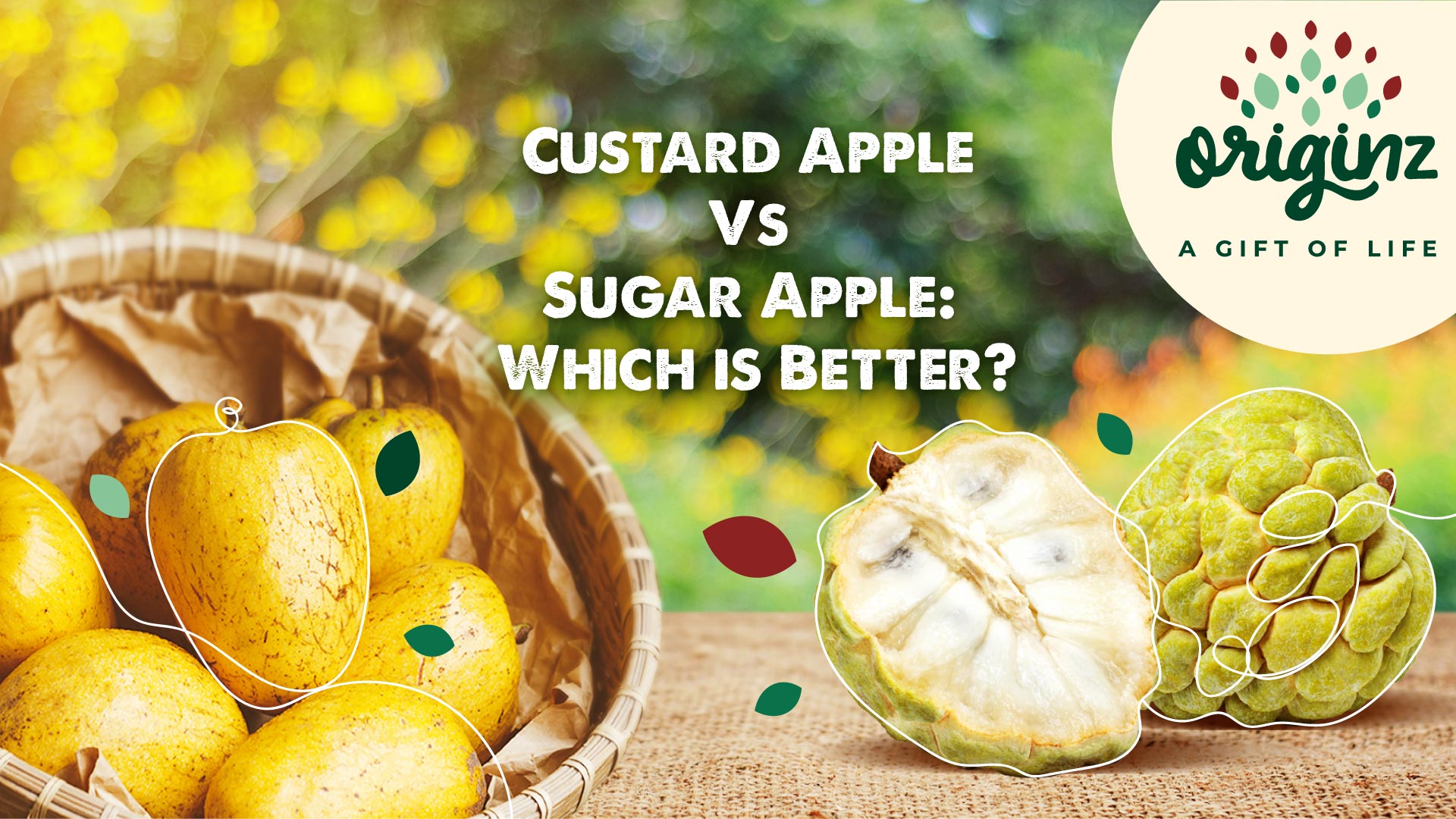
Custard Apple Vs Sugar Apple. Which is Better?
The debate between custard apple and sugar apple has been ongoing for quite some time. Both fruits have their own unique characteristics and are loved by many. In order to make an informed choice, it is important to understand the basics of these fruits and compare their nutritional values, health benefits, culinary uses, and growing conditions. Let's delve deeper into the world of custard apple and sugar apple!
Understanding the Basics: Custard Apple and Sugar Apple
Custard apple, also known as Annona reticulata, is a tropical fruit that belongs to the Annonaceae family. It has a unique flavour profile, combining hints of pineapple, banana, and strawberry. It is most known for its distinctive creamy and sweet flesh, which is often likened to custard. It is often enjoyed on its own or used in the preparation of various desserts and beverages. In traditional medicine, custard apple has been used for its healing properties.
Sugar apple belongs to the same family as custard apple, but has a round or heart-shaped appearance with a bumpy, green skin. When ripe, the skin turns yellowish-green and becomes softer. The flesh of the sugar apple is creamy and sweet, similar to custard apple but with a slightly different flavour. It is commonly eaten as a fresh fruit or used in smoothies and ice creams.
Custard and sugar apples are native to the Americas, but some coastal areas of the Middle East, especially Egypt and Lebanon, are known for producing tasty custard apples, known locally as ashta. In these regions of the Arab world, custard apples are commonly eaten as a standalone dessert food.
Nutritional Breakdown of Custard Apple
Custard apple is also rich in essential vitamins and minerals, including potassium and magnesium, and vitamins A, C, and B6. Vitamin C is known for its immune-boosting properties and its ability to protect against common illnesses. Vitamin B6 plays a crucial role in brain development and function, as well as the production of red blood cells. Vitamin A is essential for maintaining healthy vision and promoting proper growth and development. Potassium and magnesium are important for maintaining healthy heart function and regulating blood pressure levels. Magnesium is also known for its support for bone health.
Custard apple is also a good source of dietary fibre, which plays a crucial role in maintaining a healthy digestive system. The fibre content in custard apple helps prevent constipation and promotes regular bowel movements. It also aids in weight management by keeping you feeling full for longer periods, reducing the chances of snacking on sugary foods.
Nutritional Breakdown of Sugar Apple
Sugar apple is equally nutritious, providing a range of vitamins and minerals. It is a great source of vitamin C, vitamin B6, riboflavin, and potassium. The vitamin C content in sugar apple supports collagen production, promoting healthy skin and wound healing. Vitamin B6 found in sugar apple is essential for the proper functioning of the nervous system and helps convert food into energy. Riboflavin, also known as vitamin B2, plays a crucial role in energy production and supports the growth and repair of body tissues.
In addition to its vitamin and mineral content, sugar apple is a good source of dietary fibre, which aids in digestion by promoting regular bowel movements and which may reduce the risk of developing type 2 diabetes. The potassium content in sugar apple supports heart health by helping to maintain healthy blood pressure levels. Furthermore, sugar apple contains compounds with antioxidant and anti-inflammatory properties, such as Vitamin E and flavonoids. These compounds may have protective effects against chronic diseases and contribute to overall health and well-being. Sugar apple also contains iron, which is essential for the production of red blood cells and the prevention of anemia.
FAQs
How do you eat custard apples and sugar apples?
There are many ways to enjoy custard and sugar apples. They can be eaten on their own as a tasty snack, or you can scoop out the flesh with a spoon and add them to a smoothie or a lovely home-baked pastry. For some organic smoothie recipes to inspire you, visit Originz’s delicious recipes page!
Can custard apples or sugar apples help with weight loss?
Yes they can – their high dietary fibre content means that they can promote a feeling of fullness, as well as helping with clearing food from the body. Custard and sugar apples can be very helpful additions to your weight loss journey.
How do you tell if a custard or sugar apple is ripe?
The way to tell if a custard or sugar apple is ripe is if the flesh yields to gentle pressure and if the fruit has a good smell. The skin should be yellowish-green and textured.
As you can see, custard apple and sugar apple each have their own unique qualities. The choice between the two ultimately depends on personal preference in terms of taste, culinary versatility, and growing conditions. Whether you choose custard apple or sugar apple, both fruits are sure to delight your taste buds and provide a range of health benefits. So go ahead, for the best taste, visit a store with organic food products and give them a try. You will discover the wonderful world of tropical fruits!
Latest Blogs

Maintaining Healthy Habits After Ramadan
Have Ramadan healthy meals after Ramadan and maintain healthy food habits and implement them in your daily lives. Read more about healthy food habits.

Authentic Middle Eastern Iftar Meals to Prepare This Ramadan
Prepare some authentic middle eastern iftar meals this Ramadan. Look for fresh Ramadan food ideas and make your day memorable with these dishes. Check them out.

Eid-al-Fitr Feast: Delicious Recipes to Celebrate the End of Ramadan
Celebrate the end of Ramadan with delicious recipes on the eve of Eid ul Fitr. Read more about the traditional Ramadan recipes and make them easily.

Ramadan Dishes to Cure Fasting Fatigue
Don’t worry about fasting fatigue anymore as we have listed some best Ramadan dishes and easy iftar meals to support your fasting journey. Check them out.